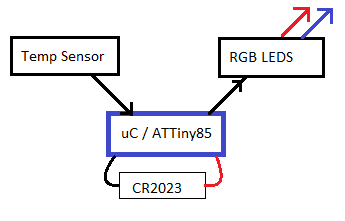I plan on using ATTiny85 do the work, since it should run on 3v
CR2023 is 3v and should have enough mA to power it and some SK6812 / 5050 RGB LEDS
And a thermresistor will sense the temp, obviously.
The end game is to dip the board in resin to waterproof and protect the board making into an actual coaster.
The bottom side of the board will have the battery holder and pads to program the Attiny85. I plan on leaving a recess in the epoxy to allow battery access. I may make a recess for the pads for debugging, but i plan to work out the code and kinks before putting it in resin
Refer the Git page for updated schematics and code
This is intended to be an Entry for the Hackaday's Coin Cell Challenge
Keeping in with the rules of the challenge, i've added the board to OSHPark
 Ray Olsen
Ray Olsen





[IMG]http://i65.tinypic.com/1118lxv.jpg[/IMG]
Did this one a few years ago :)